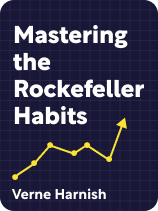

This article is an excerpt from the Shortform book guide to "Mastering the Rockefeller Habits" by Verne Harnish. Shortform has the world's best summaries and analyses of books you should be reading.
Like this article? Sign up for a free trial here.
What makes a company’s mission truly meaningful? How can you set ambitious goals that inspire your entire team?
In Mastering the Rockefeller Habits, Verne Harnish argues that every successful business needs clear direction and purpose. Understanding your organization’s core values and establishing a long-term business goal creates a foundation for sustainable growth and meaningful impact.
Keep reading to discover how to identify your company’s values and set the kind of audacious goals that transform organizations.
A Long-Term Business Goal
The first Rockefeller Habit is Focusing on a Purpose. According to Harnish, to make your company a success, you must decide on a long-term business goal you want the company to accomplish. Then, ensure that everyone in the company understands and focuses on the single most productive thing they can do to help reach that goal.
To know what long-term mission you want your business to accomplish, you must become fully aware of your business’s Core Values, argues Harnish. These values describe your business’s internal code of ethics: What should the company do, and what shouldn’t it do? What kinds of work are worth pursuing? For example, an auto parts manufacturer’s core values might include absolute dependability, creative problem-solving, and positive environmental impact.
Every company has a set of implicit Core Values, but you can’t properly align the company under this unifying direction until you become consciously aware of what they are. To identify your company’s Core Values, Harnish recommends collaborating with trusted leaders in your company to create a list of three model employees who represent the best parts of your company’s culture. Then, talk about these ideal employees and try to identify what makes them such good team members.
(Shortform note: While Harnish recommends aligning your company with the implicit Core Values it already has, Ben Horowitz argues in What You Do Is Who You Are that leaders have a responsibility to intentionally shape their company’s culture. Otherwise, the culture your employees impose on the organization by default may go against the leaders’ values. That said, Horowitz notes that studying the values of model employees you already have can be valuable, too. The strengths and values that your employees already possess are the easiest to reinforce, so do what you can to encourage existing employee habits that align with the Core Values you want to impose.)
| Advance a Just Cause Instead of Identifying Core Values Harnish pulls the term “Core Values” from the 1994 book Built to Last by Jim Collins and Jerry I. Porras (as well as the term “BHAG”), and repeats many of the ideas in that book. However, Core Values aren’t the only way to conceptualize an organization’s guiding morals. In The Infinite Game, Simon Sinek introduces the concept of a “Just Cause.” Rather than list specific Core Values that the company stands for, Sinek recommends that companies get even more concrete: Envision, in detail, an ideal version of the world that your company can work toward making a reality. This ideal world is your company’s Just Cause. The concept of a Just Cause isn’t just a goal founded on Core Values, either. Unlike the long-term goals that Harnish advocates, a Just Cause is ultimately unattainable. This is because idealistic, even unrealistic goals are the most inspiring. For instance, the mission to create a world in which everyone has unlimited access to affordable psychotherapy will probably never be finished, but progress toward a goal like this is enough to motivate a mental health charity. |
Set a BHAG to Inspire Your Team
We’ve stated that companies that Focus on a Purpose are pursuing a long-term business goal. Harnish elaborates that they should specifically be pursuing a “Big Hairy Audacious Goal,” or BHAG. This is an objective, measurable task you intend to accomplish in the next 10 to 25 years that aligns with your company’s Core Values.
Almost nothing is completely impossible on a timeframe as long as this one, so you’re free to set extremely ambitious, ridiculous-sounding goals. Dreaming big makes it easier to inspire people to work toward achieving those dreams—everyone wants to have a significant impact on the world. For instance, a company that makes healthy soft drinks could make it their BHAG to put Coca-Cola out of business by the year 2045.
(Shortform note: In Built to Last, Collins and Porras articulate this concept and coin the term BHAG. They elaborate that visionary companies typically adopt one of four kinds of BHAGs: Accomplish a major feat of service, defeat a specific dominant competitor, emulate an existing iconic company, or breathe new life into a dying or obsolete business. These four types of goals are ambitious and, importantly, self-explanatory enough that anyone in the company who hears it instantly understands what they’re trying to do and is excited by it.)

———End of Preview———
Like what you just read? Read the rest of the world's best book summary and analysis of Verne Harnish's "Mastering the Rockefeller Habits" at Shortform.
Here's what you'll find in our full Mastering the Rockefeller Habits summary:
- What an oil tycoon can teach you about business
- How knowing your business’s unique value is key to beating the competition
- Why you should create fun themes for your quarterly goals






